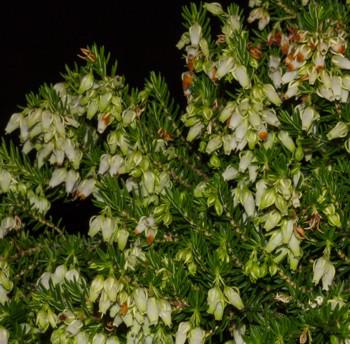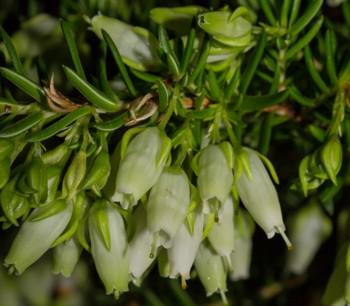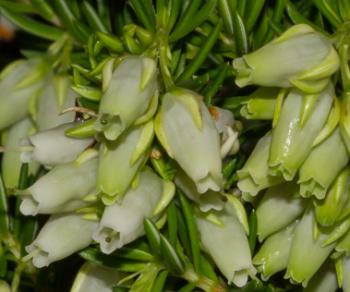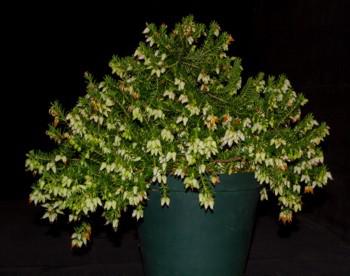Erica sociorum
Erica sociorum L.Bolus
Family: Ericaceae
Common names: Noordhoek cliff heath, partner heath, companion heath
Introduction
Erica sociorum is the most localized of all Cape Peninsula endemic ericas, and only found growing in a very limited area on cliffs above Noordhoek.

Description
Description
Erica sociorum grows as a closely branched shrublet, draped down south-facing cliffs and rocks. It forms matted clumps 150 mm tall and up to 1 m in diameter. The leaves are relatively large for Erica, strong and closely arranged on the stems.

The flowers vary from pale greenish yellow to white, with green tips. They are about 10 mm in length and hang like little urn-shaped bells from the branches. The sepals are pale creamy yellow, claw-like and appear to clasp the corolla. Erica sociorum flowers in February and March.
Conservation Status
Status
Erica sociorum is currently red listed as CR (Critically Endangered), meaning that it is at the highest level of threat before extinction. About 50 plants occur at a single location less than 1 km² and numbers are declining due to alien pine invasion of the habitat.
Distribution and habitat
Distribution description
Erica sociorum is only found in one locality on Noordhoek Mountain on the Cape Peninsula, on steep, peaty, south-facing rock ledges and cliff faces at about 700 m. It is limited to cool, moist areas that are shaded in the morning, but receive afternoon sun. The habitat is often covered by moist south-east clouds during the hot summer months.
Derivation of name and historical aspects
History
Neville Pillans and Edith Stephens collected material of this species together and gave it to Mrs Bolus. She recorded this joint collection by calling it Erica ‘sociorum’ which means, ‘of the companions’ (Latin)
Ecology
Ecology
Fynbos occurs where there are nutrient-poor soils, hot dry summers alternating with cool wet winters and recurrent fires. The plants have evolved strategies to cope with these factors. Erica leaves are small and the edges are rolled back until they almost meet under the leaf. This reduces the amount of water lost through the leaves, and enables the plant to cope with periods of drought.
Erica sociorum probably escapes or survives fires due to its habitat on moist cliffs. It is most likely pollinated by insects, e.g. bees. Flower morphology is suggestive of a generalized insect-pollination system, i.e. urn-shaped, yellowish green, anthers included, but near mouth, and the style is visible to exerted. It is also possible that it is bird pollinated, because the growth habit and habitat are very similar to those of E. halicacaba. Whereas the flowers are only 10–12 mm long, the length is within the range of bird-pollinated Erica species; and flowers are a similar colour to E. halicacaba, which we know is attractive to birds. Birds, such as sunbirds, insert their beaks into the corolla tube to feed on the nectar at its base, and in so doing, come into contact with the pollen and stigma, and pollinate the flowers. One can certainly rule out rodents due to the habitat.

Uses
Use
Erica sociorum has no known medicinal uses and has only been grown as a novelty plant. It is quite attractive and grows well in pots.
Growing Erica sociorum
Grow
Erica sociorum has all the attributes of being a difficult plant to grow, being rare, from moist cliffs high up on the mountain. It was a surprise therefore, that it proved to be very easy to root cuttings and to grow it in pots. It does not do as well in the garden probably, because it needs a very specific niche habitat, cool, moist with afternoon sun, which is difficult to replicate. Pot plants can be placed under 40% shade or where it only receives partial day sun. Be careful not to expose it to a long afternoon of baking summer sun.

Seed will probably germinate the same as most other Erica seed, but it is almost impossible to obtain. The only way seed could be obtained is by artificially pollinating the plant with a small paint brush. Should seed become available, sow it in late summer or autumn. Treating the seed with Instant Smoke Plus Seed Primer, improves germination. Use a well-drained, sandy, slightly acidic medium. Seed is very fine and needs only to be lightly covered. Use a fine gentle spray when watering and keep the trays moist and warm. Seed germinates in about six weeks and the young seedlings are very tiny and delicate. Prick them out into small grow plugs when they are 1 cm tall. Feed weekly with a dilute organic fertilizer. Pot the young plant out, when it has filled the container. The ultimate pot size for this species should be about 25 cm.
Take 20–30 mm cuttings from semi-hard wood, two months after flowering, from healthy mature plants. Heel and stem cuttings work best. Remove the leaves from the lower third of the cutting, dip into a rooting hormone and place into a tray filled with 50% peat, or milled pine bark, and 50% polystyrene. Place the trays in a propagation unit with overhead mist and bottom heating of between 22–24°C. Once the cuttings are rooted, pot them up into small plugs in multi-trays or ½ litre plastic bags. Young cuttings must be watered well and kept under shade.
Ericas are sensitive about soil. Use a well-drained growing medium consisting of a combination of river sand and well-decomposed pine bark in roughly equal proportions. The potting medium should be acidic with a pH between 5 and 6.5, containing no manure, and with low levels of phosphate.
References
- Goldblatt, P. & Manning, J. 2000. Cape Plants. A conspectus of the Cape flora of South Africa. Strelitzia 9. National Botanical Institute, Pretoria & Missouri Botanical Garden, Missouri.
- Helme, N.A. & Trinder-Smith, T.H. 2006. The endemic flora of the Cape Peninsula, South Africa. South African Journal of Botany 72(2): 205–210.
- Raimondo, D. et al. 2009. Red list of South African plants. Strelitzia 25. SANBI (South African National Biodiversity Institute), Pretoria.
- Ross Turner, personal communication
- Schumann, D., Kirsten, G. & Oliver, E.G.H. 1992. Ericas of South Africa. Fernwood Press, Vlaeberg.
Credits
Anthony Hitchcock
Kirstenbosch National Botanical Garden
February 2015
Plant Attributes:
Plant Type: Shrub
SA Distribution: Western Cape
Soil type: Sandy
Flowering season: Late Summer
PH: Acid
Flower colour: Green, White, Cream
Aspect: Morning Sun (Semi Shade), Afternoon Sun (Semi Shade)
Gardening skill: Average
Special Features:
Horticultural zones







Rate this article
Article well written and informative
Rate this plant
Is this an interesting plant?
Login to add your Comment
Back to topNot registered yet? Click here to register.